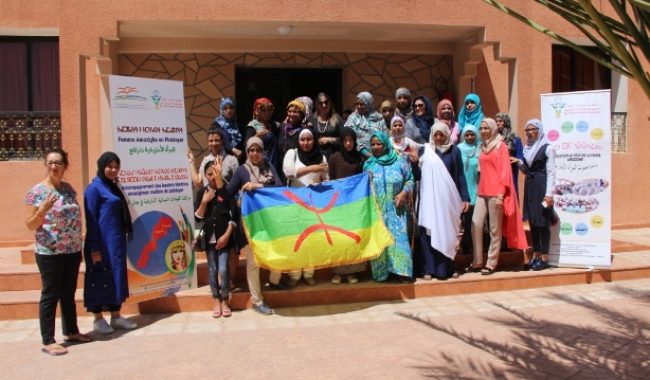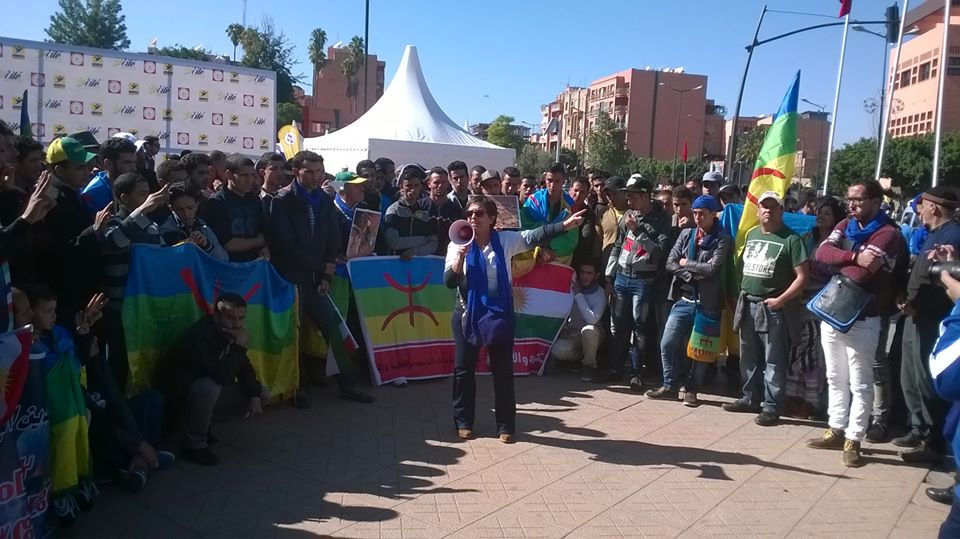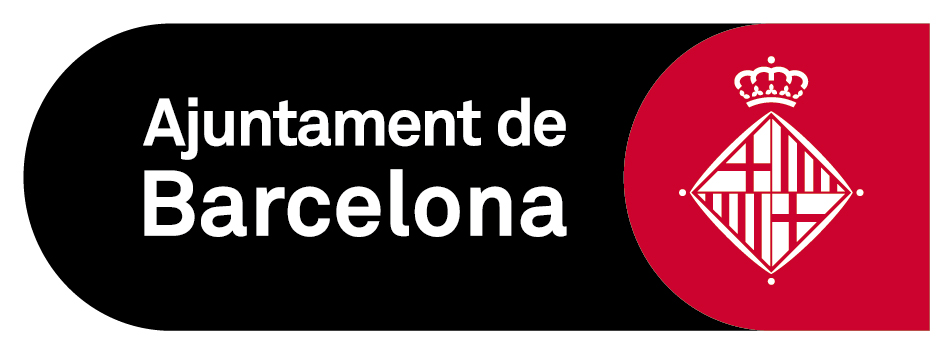Dossier
From the adversity to the pride of being an Amazigh woman
In the last years, dozens of Amazigh women’s collectives have flourished from the embers of the Amazigh movement and the changes suggested by the new Constitution in 2011, which, despite not having given the expected results, has created an opening for the popular clamour in favour of the Amazigh identity. “Voice” is the most repeated word by Zioual: it must be for this reason that one of the rooms in her locale harbours the first community radio station of Rabat and of Amazighs. The fact that the 2011 Constitution set a turning point in the demands of the Amazigh movement —by recognizing it as an official language— was, in part, thanks to the leadership of the women in the protests.
 A training course on the rights and freedoms of Amazigh women. On the left, Amina Zioual.
A training course on the rights and freedoms of Amazigh women. On the left, Amina Zioual.For years, women have been raising their voices in Morocco, especially in the times of Hassan II, the father of the current king, Mohammed VI. After eight years of stagnancy, the statute law that elevated Amazigh to being a national language, at the same level as Arabic, was finally enacted this year, 10 July. “Officialization of the language is not only the Amazighs’ right, but also it is the right of other peoples of Morocco. The next step in this transitional phase of 5 to 10 years is that the schools, administrations, courts and the Parliament would adopt simultaneous translation in every session,” Noureddine Mediane states, Riffian deputy and the head of the parliamentary group of the nationalist and conservative political party Istiqlal (Independence Party).
With the creation of the Association of Independent Women in 1944, this political formation incorporated the demand for women’s rights in its ideological approaches. Various women carried the flag for the struggle against colonial occupation. And yet, the exclusive demand for the rights of Amazigh women was never a priority for a nationalist party that, on the other hand, supported the Arab-Muslim character of the Maghreb country. Of course, in the last decade there has been a twist, following the king’s speech on the recognition of the Amazigh identity, which has allowed Istiqlal to include new voices from Amazigh women in their ranks.
Social and cultural resistance of the Amazigh women
The progress regarding the recognition of Amazigh people’s cultural, social, political and linguistic rights was achieved by women’s resistance; especially in the cultural field, where poetry, art, music and folklore were carried through a single common thread: Amazigh women. Amazigh culture, which is clearly associated with women, discreetly faced the context of centralization and Arabization initiated by Hassan II and his vision of the construction of the State. Zioual exhibits the colours of her native land on the walls of the association: the paradisal Tafilalt oasis in the village of Aït Khabbash, where women preserve the Amazigh tradition of rug knitting in bright colours. They embroider their night quilts, paint their faces with saffron, wear jewellery on the hands and arms. This does not mean showing off the material goods but unveiling the arts made by and for the women that symbolize a social group.
Clothing, tattoos and jewellery have been the public declaration of Amazigh culture: a fascinating artistic ritual that Morocco is now proudly appropriating in its national festivals as an example of identity diversity. Thus, control over these Amazigh identity symbols has given power and prestige to the Amazigh women, who have been considered, as happens in so many Bedouin cultures, emancipated and rebellious. “And yet, the patriarchism led by Arab sexism has interfered with our culture, and eroded our ways of life and traditions,” claims Zioual.
The interpretations of Islam in the hands of Arab scholars, limiting and oppressing the spaces of women, also impacted the Amazigh identity. The latest study carried out in 2015 by The Voice of Amazigh Women for a better understanding of the political participation of Amazigh women shows that religious authorities and the tradition —understood as the exclusion of women from the public space— had an influence for supplanting Amazigh women from the political field.
Besides sexist interpretations of Islam, ferocious patriarchism played a fundamental role in the discrimination of Amazigh women. “So, where does the real definition of tamghart remain?”, asks Malika Khalil. She retrieves this concept of the Amazigh tradition, deriving from amghar(‘chief’, in Amazigh), who leads and holds power. However, tamghart always refers to female leaders. This had allowed women and men to be on an equal footing.
Khalil is a parliamentary member of the Authenticity and Modernity Party (PAM), founded in 2009 by the Moroccan official administration to face its staunch rival Justice and Development Party (PJD), the Islamist party currently heading the government coalition in Morocco. The PAM has got hold of the progressive feminist discourse in order to promote an improvement in the social, economic and linguistic conditions of women in general, and of Amazigh women in particular. “Since the foundation of the PAM we have contributed to the emancipation of more than a thousand Amazigh women,” says the parliamentarian.
However, despite its constant struggle, the female leadership of the Amazigh identity faces the reality of the social norms that confine women strictly to the domestic space. “The visions of the Eastern man”, alluding to the mentality of the Wahabite doctrine of the Near East, “have been used as a reference by the Amazigh men in order to marginalize women and to convince themselves for sexist behaviour, exclaiming that everything is ‘haram’ (‘forbidden’, in Arabic),” says Khalil. “Not only do we face the inequalities promoted by our immediate circle but also, and on top of it, we must deal with the rigorous ideology that accuses us of being unbelievers and opponents of the values of Islam,” she adds.
The need for Amazigh women to have their own voice
“At the beginning of the 2000s, the [Amazigh] women’s movement was born from a more political perspective because we felt that the Moroccan feminist movement was taking Arabic culture as reference when it came to talking about our history. We saw the oversight regarding the native Amazigh culture as a source, as well as the historical construction of this country. We have incorporated our rights to this demand, which are the same for all women in the country,” comments Meryam Demnati, the head of the Women’s Committee at the Observatory of Amazigh Rights and Freedoms, and the coordinator of the Amazigh Women’s Forum of Tamazgha. “Although our limitations as an identity pushed us to create associations based on the Amazigh issue, we consider ourselves as the Amazigh voice of the whole nation,” she adds. Demnati’s activity niche is placed especially in rural areas, because the Amazigh women there suffer a greater exclusion: They do not have access to schools, and they are exposed to early marriages.
The signs of persisting illiteracy and unemployment reveal the linguistic violence that Amazigh women continue to undergo. Women in rural areas generally speak Amazigh only. So, when they have to resort to local authorities —which are often originated in non-Amazigh areas— it becomes impossible for them to communicate. “They have difficulties in explaining their pain to a doctor, or an ill-treatment to a police officer. And it is impossible for them to defend themselves in a court. What kind of a protection do these women receive?”, asks Amina Ibnou Cheikh, an activist and the director of the newspaper Le Monde Amazigh. “We need interpreters for these women, both in rural areas and in the big Moroccan cities where many of them have emigrated for work and find it difficult to communicate,” she adds. The migration has been the only means of social mobility for poor rural Amazigh women who, once in the city, have needed to adopt the Arabic language.
 Amina Ibnou Cheikh, Amazigh journalist and activist. / Image: Rachid Raha.
Amina Ibnou Cheikh, Amazigh journalist and activist. / Image: Rachid Raha.Taking into account their social condition, and for not having enough means to learn the standard language, this social group undergoes exclusion and isolation. Amina Zioual has been working on the lack of protection of the Amazigh language and culture. She takes pride in strong activism both in the countryside and in the city so that the Amazigh women know about their rights. Despite the accrued experience of Amazigh women’s associations and their enormous contribution to the mobilization of identity, challenges are even bigger. Amazigh women continue facing the hogra, humiliation: everyday they feel the unfair and discriminatory treatment of public administrations and institutions, where they can hardly express themselves in Amazigh language. “Do you know how many times I need to say to my fellow citizens, ‘These people do not speak Arabic’?” stresses Demnati. Her struggle includes Amazigh women’s recovery of language and culture, and their full inclusion into society.
“Our children are the victims of marginalization. They feel that their language is worth nothing, as if they were [just some] barking dogs. It is such a contempt that many families refuse their children preserving their [own] language, and they are being sensitized to learn Arabic, the language of the Koran,” Demnati exclaims. Both she and Zioual acknowledge the enormous challenge for the Amazigh women’s movement; not only do they have to sensitize the institutions but also the public opinion and the very Amazigh families, in order for them to defend their identity flag and retrieve their language as the basis of the entire collective.
Beyond the recent recognition of the language, this women’s collective understands that it is time to overcome yet another barrier: the registration of names, which are, to this date, all in Arabic. “Our freedom comes by calling our children with the names we want. The opposite of this is a violation of human rights. We demand that this issue be reviewed to guarantee the right to choose a name and acquire legal personality without discrimination,” says Zahra Ouhssain, a journalist on Amazigh national television and the vice president of the Amazigh National Association for the Citizens, Azetta Amazigh. Founded in 2002, the organization defends and promotes Amazigh language and culture, and it has achieved a greater popular legitimacy for the Amazigh movement, compared to the Royal Institute for Amazigh Culture in Morocco (RIACM), which is often qualified as “less independent”.
Ouhssain does not conceal the satisfaction brought about by the materialization of the statute law that equated Amazigh language to Arabic. From now on, women will teach their culture with less anxiety, through the three colours of the blue, green and yellow flag, and on top of that, in the Tifinagh script.
It is an important life sign for the continuity of the Amazigh movement. There will be many others remaining for the struggle for the rights of Amazigh women. For example, the struggle for the rights of LGBT community, which probably will not be seen in this century: It is not on the agenda of this social movement nor others because it does not fit the Muslim tradition. Homosexuality is considered a crime and entails imprisonment; so its open claim, for now, is an illusion. However, these restrictions have not prevented the emergence of illegal collectives —though tolerated to a certain extent— such as Kifkif (“Equal to Equal” or “The Same”) or Aswat, which move stealthily on social networks to make progress in the defence of the rights of the homosexual people in Morocco.
The challenge is not only institutional but also popular. Sometimes, the attacks by the society against the LGBT community are greater than those exercised by the authorities themselves. Therefore, the omission of the criminal code articles that condemn this community will be insufficient, if public policies that contribute to the transformation of mentalities are not initiated before.
(Translated from Catalan language by CollectivaT.)
With support from:



